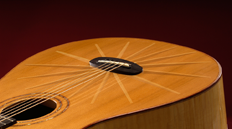The Big Ben Story

My grandfather, Ben W. Taylor (1907 - 1984) built his first guitar in 1936. He was an extremely talented, natural luthier who during the 1950s and 60s perfected "thin neck technology". These efforts set a new standard for comfort and playability. As a boy, I began working with him in the 1950s. Through the years, we built many guitars together.
Early in the 1970s, I began experimenting in an effort to create a new, big sound that
I could only hear in my head. One day, while working for private industry in research and development, I was waiting for a computer printout and a vision came into my head. The vision was of a water spider sitting on the surface of the water. I hadn't thought about water spiders since I first saw them as a child. I knew immediately that this vision was a gift. By applying the principles of load distribution that allow the water spider to sit on the water's surface, I was able to change the structure of the guitar's soundboard. This allowed me to distribute the load of string tension and stabilize the soundboard, making possible a perfect development platform for a new, big guitar sound.

The shape of the guitar affects its sound. Most traditional shapes were created before or during the 1930s. Much science in acoustic architecture has been done since that time. The problem with traditional guitars is that standing waves get set up inside the body and prevent the instrument from sounding even across the guitar's frequency spectrum. During the 1980s, I began to develop body shapes that solved this problem.
Action on a guitar has to be correct or it will be difficult to play. On traditional guitars, bridge saddle height adjustments allow action to be set, but at the expense of sound quality. A solution to this problem is to separate the string action adjustments from bridge saddle height adjustments. By mounting the neck of the guitar in a sliding dovetail joint, the action can be set at any comfort level for the player without any change in sound quality.
During the 1990s, a patent was issued for the Distributed Load Soundboard System and the Sliding Dovetail Neck Mount. Prototype guitars were built incorporating my grandfather's "thin neck technology", with my Distributed Load Soundboard System, new acoustic architecture, and Sliding Dovetail Neck Mount.

The next step was to get guitars into the hands of great players to get their reaction. I am indebted to Chet Atkins, Ron Block, Liona Boyd, Michael Hedges, Janis Ian, Wayne Johnson, Phil Keaggy, Jerry Kimbrough, Danny Parks, Richard Smith, Martin Taylor, Brett Terrell, Dan Tyminski, Frank Vignola, Sandy Williams, Paul Yandell and many others for taking the time to test-play my guitars.
I refused to put my guitars on the market until I was completely satisfied that the instruments reproduced that big sound I heard in my head all those years ago. Though it has taken many years, I am delighted with the dynamics, versatility, playability, purity of tone and big sound that my guitars produce. Additionally, my guitars are structurally sound and designed to last for hundreds of years.
In honor of my grandfather, Ben W. Taylor, I've named this new guitar, "Big Ben". I am proud to present Big Ben Guitars. Let me build one for you.
Ben Taylor, Luthier
